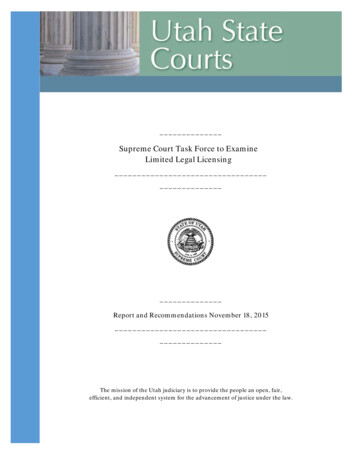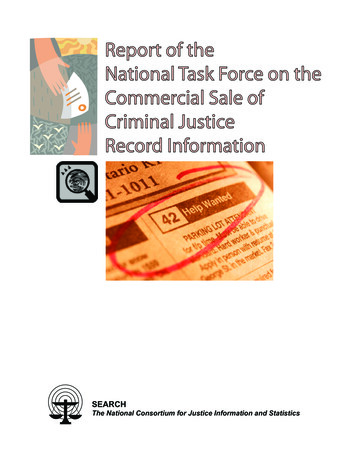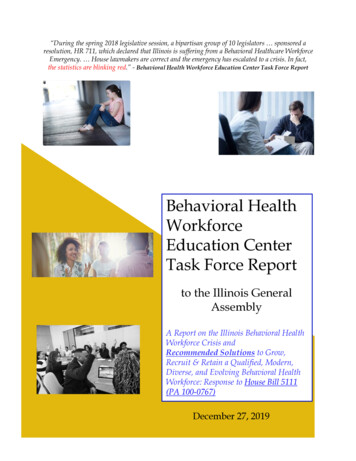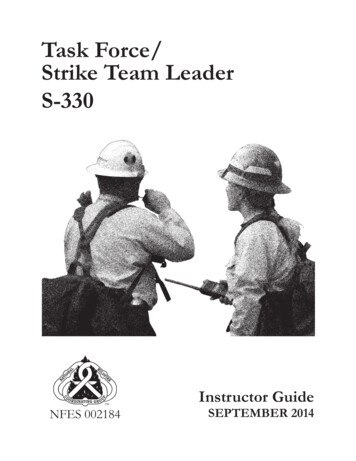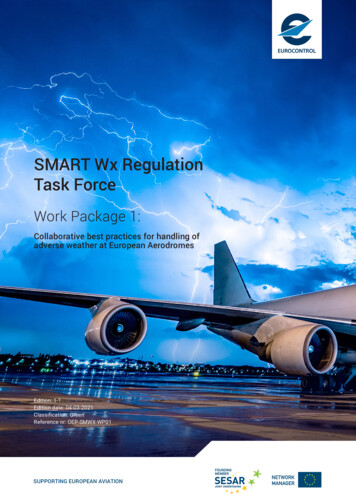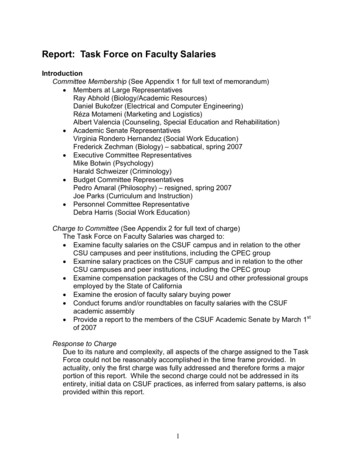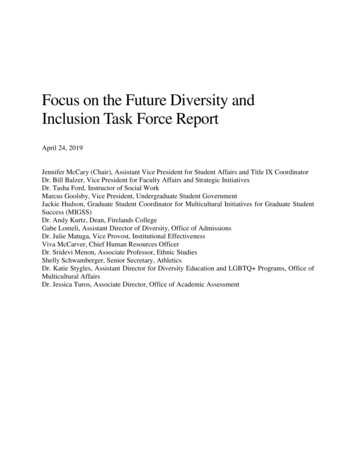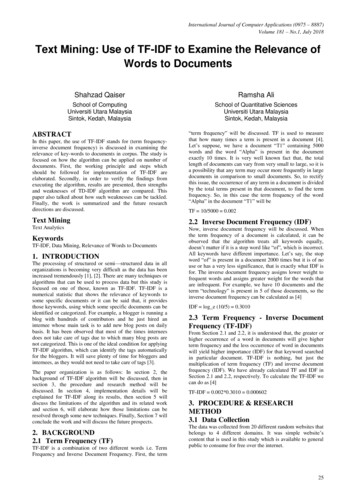
Transcription
The Supreme Court of OhioReport and Recommendations ofThe Supreme Court of OhioTask Forceto Examine the Ohio Bail Systemjuly 2019
REPORT & RECOMMENDATIONS OF THETask Force to Examine the Ohio Bail Systemjuly 2019MAUREEN O’CONNORChief JusticeSHARON L. KENNEDYJUDITH L. FRENCHPATRICK F. FISCHERR. PATRICK DeWINEMICHAEL P. DONNELLYMELODY J. STEWARTJusticesSTEPHANIE E. HESSInterim Administrative Director
TASK FORCE MEMBERSHon. Mary Katherine Huffman, ChairSara AndrewsHon. Andrew BallardMichael BarhorstVallie Bowman-English Esq.Russell Brown Esq.Gwen Callender Esq.Daniel Dew Esq.Julie EhemannHon. Tavia GalonskiHon. Todd GraceMeghan GuevaraHon. Brian HaganHon. Brett Hudson HillyerTim Horsley Esq.Hon. Mark HummerJames LawrenceLisa LargeHon. Rob McColleyBranden MeyerCharles Eddie MillerChristopher NicastroJocelyn Rosnick Esq.Hon. John RussoTom SauerHamilton County Pretrial Services & President, OhioAssociation of Pretrial Services AgenciesSheriff Larry SimsWarren County Sheriff & President, Buckeye State Sheriffs’AssociationMichael Streng Esq.Hon. Cecil ThomasJudy Wolford Esq.Timothy Young Esq.Montgomery County Court of Common PleasLawrence County Court of Common PleasClerk of Court, Toledo Municipal CourtChief Legal Counsel, Fraternal Order of Police of OhioShelby County Commissioner & President, CountyCommissioners Association of OhioAthens County Municipal CourtRocky River Municipal CourtCincinnati City ProsecutorPresident, Oriana HouseOhio SenatePresident, Ohio Bail Agents AssociationPolicy Director, ACLU of OhioPresident, Ohio Association of Criminal Defense LawyersBridges, Jillisky, Streng, Weller & GulliferPickaway County Prosecuting AttorneyDirector, Ohio Criminal Sentencing CommissionMayor of Sidney & President, Ohio Municipal LeagueCourt Administrator, Cleveland Municipal CourtLegal Fellow, The Buckeye InstituteOhio House of RepresentativesPretrial Justice InstituteOhio House of RepresentativesFranklin County Municipal CourtPresident, Ohio Association of Municipal/County Court ClerksPresident, Ohio Clerk of Courts AssociationChief of Criminal Justice Services, Ohio Departmentof Mental Health & Addiction ServicesCuyahoga County Court of Common PleasOhio SenateOffice of the Ohio Public DefenderTasha Ruth Esq., Staff Liaison
Report & Recommendations Task Force to Examine the Ohio Bail SystemHon. Maureen O’ConnorChief JusticeSupreme Court of Ohio65 South Front StreetDear Chief Justice O’Connor:Enclosed please find the final report and recommendations of the Supreme Court TaskForce to Examine the Ohio Bail System. We were charged with reviewing andrecommending improvements to Ohio’s current bail system by: Studying the bail and pretrial systems used in other states; review any federal or statelitigation pertaining to the use of bail and/or the elimination of cash bail; Determining whether courts should be required to use a pretrial risk assessmenttool and, if so, whether that tool should be a validated tool; Reviewing the use and utility of bond schedules; and Reviewing Ohio’s bond practices to determine the appropriate balance betweenrecognizance bonds, pretrial monitoring, and cash or secured bonds.I would like to thank the members of the Task Force for their hard work and carefulin-depth study and review of Ohio’s bail and pretrial system. I appreciate the Task Force’swillingness to consider all perspectives on the issues presented and engage in constructivediscussions that ultimately resulted in nine recommendations. It is our hope that the reportof the Task Force fulfills the charge we were given.On behalf of the members of the Task Force, I thank you for the opportunity to serve,participate, and offer recommendations on these important issues.Hon. Mary Katherine Huffman
TABLE OF CONTENTSPageINTRODUCTION1Overview1Work of the Task Force3REPORT & RECOMMENDATIONSRecommendation 155Require Validated Risk Assessment ToolRecommendation 26Amend Sup.R. 5Recommendation 37Amend Crim.R. 46Recommendation 47Require Presence of CounselRecommendation 58Tailor Pretrial ServicesRecommendation 68Consider Alternatives to DetentionRecommendation 79Leverage TechnologyRecommendation 810Educate & Train Judges & Court PersonnelRecommendation 911Uniform Data CollectionAppendix A13Amendments to Crim.R. 46, as proposed byThe Commission on the Rules of Practice& ProcedureAppendix BTask Force Presenters19
Report & Recommendations Task Force to Examine the Ohio Bail SystemINTRODUCTIONOVERVIEWThe American judicial system is built upon the foundational principle that those accusedof a crime are “innocent until proven guilty.” However, for those who are arrested andjailed prior to trial because they cannot afford to pay a monetary bond, the notion of beingpresumed innocent in the eyes of the law has little relevance.Pretrial is the part of the criminal justice system that begins when a person is arrested andends when any resulting charges are resolved – usually through a dismissal, a plea, or atrial. A critically important element of the pretrial process is deciding whether an accusedperson should be released until his or her court date – or detained in jail because ofconcerns about public safety or to ensure court appearances. “Bail” refers to the conditionsa person must adhere to in order to be released pretrial. Although many people associatethe term with secured money bail, it also can mean nonmonetary conditions – such asagreeing to check in regularly with a pretrial officer, or to undergo drug or alcohol testing. 1According to the National Center for State Courts’ 2018 State of the State Courts Analysis, 2based on a survey of 1,000 voters conducted in November 2018, voters are primed for adiscussion on cash bail. Voters acknowledge the unfairness of cash bail and are open toreform, including allowing judges more discretion in pretrial release decisions. Whenvoters were presented with the option of allowing “judges to determine whether adefendant should be detained based on their individual case, previous offenses, andpersonal circumstances” as an alternative to cash bail – similar to that of the policy adoptedby California earlier this year – nearly three-quarters (73%) supported this proposal andonly a quarter (24%) opposed. The proposal received strong support across party andracial lines.Voters participating in the survey found the following statements tested in this survey to beconvincing reasons to support cash-bail reform: People who cannot afford their bail are locked up while their cases go through thecourts, which can take weeks, months, or even years. While waiting for a trial, thesedefendants are at risk of losing their job, custody of their children, and their home,all without being convicted of a crime. (74%)1Pretrial Justice Institute, Ohio Wants a Common Sense Approach to Pretrial (2018).2National Center for State Courts, 2018 State of the State Courts – Survey Analysis (2018).1
Report & Recommendations Task Force to Examine the Ohio Bail System Sending defendants to jail who can’t afford to post bail is a bad investment fortaxpayers. The majority of defendants jailed while awaiting trial are lower-risk andcharged with non-violent crimes. But it costs U.S. taxpayers approximately 38million every day, or 14 billion annually, and makes it harder for the justice systemto focus on keeping our communities safe from violent felons. (70%)According to a Pretrial Justice Institute poll of Ohio voters in 2018, Ohioans think thereshould be fewer arrests for low-level offenses, more support services in the community, anda system focused on public safety, not on the ability to pay a monetary bond. Roughly 57percent of inmates in Ohio jails are not there serving a sentence, but instead are awaitingtrial, according to Ohio Department of Rehabilitation and Correction data. They arelocked up because they cannot afford bail. Research shows that jail in Ohio is far moreexpensive than supervised release, with the average jail bed costing almost 65 per day,compared to 5 per day for maximum supervised release. 3Pretrial detention exacts a human cost in addition to a fiscal one. Studies have shown thatas few as three days in jail can make those who are detained more likely to offend in thefuture – likely because detention disrupts stabilizing factors such as employment, housing,health, and education. 4 More than one in 10 Ohio children – over a quarter million kids –has experienced the absence of a parent due to incarceration in jail or prison. 5In spite of earning a “C” in a 2017 report, The State of Pretrial Justice in America, Ohio wasnamed a “state to watch” because several of the state’s most populous jurisdictions aretaking steps to maximize pretrial release. These initiatives include diverting people awayfrom the criminal justice system when they could be better served elsewhere, creating datainformation systems, and replacing money bail with pretrial assessment. 6 In Lucas County,implementation of the Laura and John Arnold Foundation Public Safety Assessment toolhas resulted in an 18-percent reduction in the number of people incarcerated pretrial.Cuyahoga County conducted a data analysis of its jail populations and has been workingwith the Pretrial Justice Institute on recommendations regarding needed improvements tothe bail system. Ohio also is participating in the Stepping Up initiative, which seeks toreduce the number of people with mental illnesses involved in the criminal justice system. 73The Buckeye Institute (May 2018).4Christopher T. Lowenkamp, Marie VanNostrand, and Alexander Holsinger, Hidden Costs of Pretrial Detention, Laura and JohnArnold Foundation (November 2013).5The Annie E. Casey Report, A Shared Sentence, found that 271,000 children in Ohio have been affected by a parent’sincarceration in jail or prison; the Children’s Welfare League of America estimates that 2.6 million children live in Ohio.6Pretrial Justice Institute, Ohio Wants a Common Sense Approach to Pretrial (2018).7Pretrial Justice Institute, The State of Pretrial Justice in America (November 2017).2
Report & Recommendations Task Force to Examine the Ohio Bail SystemWORK OF THE TASK FORCEThe Task Force to Examine the Ohio Bail System endeavored to meet its charge at anaggressive pace, meeting several times in less than four months. The Task Force enlistedthe assistance of the Pretrial Justice Institute (PJI), a national organization striving to makepretrial practices safer, fairer, and more effective. PJI’s technical expertise,encouragement, and advice helped Task Force members learn about emerging pretrialpractices in other states and participated in proposing improvements in Ohio.In an effort to better inform their process, the Task Force invited stakeholders from acrossthe state and beyond to a question-and-answer session. Individuals from the followingorganizations presented testimony: Ohio State Bail Bond Association, Ohio ProfessionalBail Association, American Bail Coalition, Triton Management Services, LLC, Ohio ChiefProbation Officers Association, Ohio Justice and Policy Center, Bowling Green StateUniversity, Office of the Cuyahoga County Public Defender, Lucas County Criminal JusticeCoordinating Council, and Lucas County Common Pleas Court. (Appendix B) Writtentestimony also was solicited and received from the Ohio Department of Rehabilitation andCorrections and the Montgomery County Jail Treatment Coordinator. These pretrialjustice system stakeholders provided information on: The pros and cons of a money bail system and/or bail bond schedule;Data results following the elimination of money bail or a bond schedule, specificallypertaining to failure-to-appear (FTA) rates, jail population, and financial impact;Information regarding the use of risk assessment tools; andExperience using evidence-based alternatives to pretrial detention.The Task Force also relied upon the Ohio Criminal Sentencing Commission’s Ad HocCommittee on Bail and Pretrial Services Report and Recommendations to guide thediscussion. In 2017, the Ad Hoc Committee made recommendations to reform and createa system of pretrial justice that maximizes appearance, preserves public safety, protects thepresumption of innocence, and achieves efficiencies and consistency in Ohio’s pretrialsystem, while decreasing the reliance on monetary bail as the primary release mechanism. 8The Task Force carefully reviewed each of the Ad Hoc Committee’s six recommendationsand the proposed changes to Criminal Rule 46 in order to develop this report andrecommendations.8Ohio Criminal Sentencing Commission, Ad Hoc Committee on Bail and Pretrial Services Report and Recommendations (2017).3
Report & Recommendations Task Force to Examine the Ohio Bail SystemThe Task Force recognizes the importance of implementing an effective pretrial systemthat keeps the public safe, ensures that individuals accused of crimes appear in court asordered, and, in accordance with the U.S. Constitution, respects the presumption ofinnocence by not unfairly interfering with the freedom of people who have not been foundguilty. These recommendations serve as an important step toward ensuring an effectiveand just pretrial system for Ohioans involved in the legal system.4
Report & Recommendations Task Force to Examine the Ohio Bail SystemREPORT AND RECOMMENDATIONSRECOMMENDATION 1:Require a validated risk assessment tool be available to the judge in every municipal,county, and common pleas court when setting bond or conditions of bond.Pretrial risk assessments are conducted to provide information about the risk of failure thata given defendant poses if released before disposition of his or her case and to providestandardized measures for informing pretrial dispositions. Typically, failure is defined asfailure to appear for the scheduled court date and/or re-arrest for further criminalviolations prior to adjudication. 9 Pretrial risk assessment tools are designed to inform, notreplace, the exercise of judicial decision-making and discretion. The results produced bypretrial risk assessment tools should be considered transparently and on the record withina range of pretrial release guidelines. Pretrial risk assessment tools provide group-basedinformation that may support pretrial decisions, while still allowing for judicial discretionthat accounts for the facts and circumstances of an individual case. 10 A pretrial riskassessment tool is merely another tool in a judge’s tool box to use in making an informeddecision. The Task Force adopts the Ohio Criminal Sentencing Commission’srecommendation that, in addition to the current factors listed in Crim.R. 46(C), 11an evaluation of a defendant’s likelihood of appearance and risk to public safety, asdetermined by a validated risk assessment tool, should also be considered whensetting bond or conditions of bond. The Task Force recommends a Supreme Court committee be formed to reviewavailable validated risk assessment tools and publish the list to the Supreme Courtof Ohio’s website. The Task Force recommends that both interview-based and noninterview based assessment tools be reviewed and published. The committee should9Charles Summers, Ph.D. and Tim Willis, Ph.D., Pretrial Risk Assessment, Research Summary, Bureau of Justice Assistance(October 2018).10Desmarais, S. & Lowder, E. M., Pretrial risk assessment tools: A primer for judges, prosecutors, and defense attorneys (2019).11Crim.R. 46(C) lists the following factors to consider when setting bond or conditions of bail: 1) the nature andcircumstances of the crime charged, and specifically whether the defendant used or had access to a weapon; 2) the weight of theevidence against the defendant; 3) the confirmation of the defendant’s identity; 4) the defendant’s family ties, employment, financialresources, character, mental condition, length of residence in the community, jurisdiction of residence, record of convictions, recordof appearance at court proceedings, or of flight to avoid prosecution; and 5) whether the defendant is on probation, a communitycontrol sanction, parole, post-release control, bail, or under a court protection order.5
Report & Recommendations Task Force to Examine the Ohio Bail Systemensure the tools it recommends are validated using Ohio data and that the tools arerevalidated periodically throughout their use in order to ensure the tools arepredicting new (violent) offenses and FTAs. The committee should develop a guideto assist Ohio courts in implementing and using a risk assessment tool. The Task Force recommends the General Assembly, in conjunction with theSupreme Court of Ohio, ensure assistance is available to courts that may lack theresources needed to implement these tools. The Task Force further recommends,as resources and infrastructure permit, the development of a statewide system thatcan facilitate the implementation of a risk assessment tool and provide a mechanismfor data collection that could be used for validation and measuring performance.Individual courts with more robust pretrial services would have the option of usingadditional risk assessment tools, including interview-based tools, but they also wouldhave the standardized data provided by the statewide system. (See Recommendation9) The Task Force adopts the Ohio Criminal Sentencing Commission’srecommendation that the General Assembly should ensure appropriate resourcesfor any required data collection regarding bail and pretrial services.RECOMMENDATION 2:Ohio’s Superintendence Rule 5, Local Rules, should be amended to require counties withmore than one municipal or county court to adopt a uniform bond schedule to be used byeach court in the county.Currently, Crim.R. 46(G) allows courts to establish a bail bond schedule covering allmisdemeanors including traffic offenses, either specifically by type, by potential penalty, orby some other reasonable method of classification. Bond schedules in Ohio’s municipalcourts vary widely across jurisdictions and even within the same county. Where there are multiple municipal or county courts in a county, the Task Forcerecommends that the Sup.R. 5 require courts to adopt a uniform bond schedule tobe used by each court in the county. The bond schedule only should be used whena judicial officer is not available to make a determination.6
Report & Recommendations Task Force to Examine the Ohio Bail SystemRECOMMENDATION 3:The Task Force recommends the Supreme Court of Ohio adopt the amendments toCrim.R. 46 as proposed by the Commission on the Rules of Practice and Procedure asreflected in Appendix A.RECOMMENDATION 4:Crim.R. 44 should be amended to require the presence of counsel for the defendant at theinitial appearance for any offense carrying the potential penalty of confinement, unlessthe defendant is being released on an unsecured financial condition or on personalrecognizance. The rule shall not impede or delay the judge’s ability to release a defendanton his or her own recognizance or an unsecured financial condition.The practice of ensuring the presence of counsel for the defendant at the initialappearance before a magistrate or judge, when the defendant learns the charge againsthim or her, and his or her liberty is subject to restriction, marks the initiation of adversarialjudicial proceedings. 12 This triggers the attachment of the Sixth Amendment right tocounsel. 13 Currently, Crim.R. 44(A) states: “Where a defendant charged with a serious offense isunable to obtain counsel, counsel shall be assigned to represent him at every stageof the proceedings from his initial appearance before a court through appeal as ofright, unless the defendant, after being fully advised of his right to assigned counsel,knowingly, intelligently, and voluntarily waives his right to counsel.” Crim.R. 44(B)states that for petty offenses, counsel may be assigned. The Task Force recommendsthat Crim.R. 44(A) be amended to include any offense carrying the potentialpenalty of
recognizance bonds, pretrial monitoring, and cash or secured bonds. I would like to thank the members of the Task Force for their hard work and careful in-depth study and review of Ohio’s bail and pretrial system. I appreciate the Task Force’s willingness to consider all perspectives on the issues presented and engage in constructive
